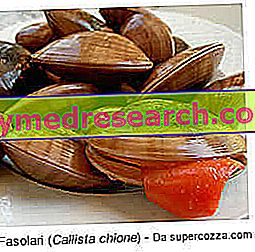Generality
The fasolari are fishery products. These are bivalve molluscs (or lamellibranches) belonging to the Veneridae family, Genus Callista, Specie chione ; the binomial nomenclature of the fasolari is Callista chione .

Description
The fasolari have a shape similar to clams, sea truffles, hearts and donax; they have an oval shell, consisting of two symmetrical parts (valves), joined by a hinge (in correspondence with which the growth point is located - umbone). The valves open and close to allow water to filter; the closing of the latter takes place thanks to the adductor muscles of the internal mollusk. The external coloring of the fasolari is light brown, with lighter and darker rays starting lengthwise from the hinge to the edge of the valves; transversal lines are also evident. The inside of the shell is white, with shades that recall ceramic. The inner and outer surface of the valves is completely smooth. The internal mollusk has a variegated pigment: light yellow, dark yellow and bright red.
The fasolari are larger than the clams: they reach 10cm in diameter and 100g in weight.
Habitat
The fasolari colonize the Mediterranean basin and a part of the Atlantic Ocean (especially the north-eastern one). They prefer areas not far from the coast, on sandy and / or muddy bottoms between 15-20m of depth (not less than 10, not more than 30m), in which they dig and remain underground. The fasolari gather above all in correspondence of the bumps (elevations of the marine ground), primary characteristic of the backdrops of the high Adriatic sea and of the Lazio. They feed by filtering the water and holding the food in a similar way to clams; reproduction takes place in spring.
Fishing
The fasolari fishing takes place by means of large turbo-blowing hydraulic dredges; unlike that of clams, the fishing of fasolari was never carried out significantly with manual techniques, since the depths on which they live are completely inaccessible. Unfortunately, fasolari fishing does not spare these molluscs even during the reproduction period and covers all 12 months of the year.
Gastronomic uses
The fasolari are seafood. It is a not very precise classification but which defines quite clearly the culinary applications of the shellfish in question.
Unlike clams, the fasolari are not able to purge completely, even if left several days in water and salt. To cook them it is therefore essential to open them manually (raw) and wash them with care; some suggest keeping their internal liquids, but personally I think it is an operation that excessively increases the risk of sandy residues in the finished product. The opening operation takes place by means of a paring knife or an oyster knife, better if protecting the hands with the metal mesh gloves. It is therefore necessary to insert the blade in the slot between the valves and to sever the adductor muscles or to force, by levering with the blade, the shell. Once opened and cleaned, the fasolari are ready to be: boiled or steamed (to enrich the seafood salad or the Catalan), sautéed with wine and parsley (sauté of fasolari, with or without tomato), baked au gratin with a little garlic breadcrumbs, parsley, pepper and white wine. The fasolari are an extremely used ingredient in the formulation of pasta dishes based on fresh pasta and risotto. A recipe that everyone should taste is: Black tagliatelline with fasolari, rapari (or shelled murici) and fresh parsley .
NB . The fasolari have an extremely firm consistency; this means that excessive cooking would lead to the hardening of the mollusc (especially of the foot), increasing chewing difficulties. On the other hand, insufficient heat treatment could increase the risk of contracting the HAV virus (viral hepatitis type A). Some suggest crushing the fasolaro clam with a meat pounder before cooking.
Many like the taste and consistency of raw fasolari, although the risk of contracting certain serious food diseases (such as the aforementioned) is clearly present.
See also: raw fish, risks and benefits
Nutritional characteristics
The fasolari are low-calorie foods suitable for slimming purposes; they contain an excellent supply of high biological value proteins and small amounts of lipids, while carbohydrates are almost absent. However, like the other bivalve molluscs, the fasolari are the object of numerous forms of food allergy and their consumption is not recommended especially in the case of pregnancy and feeding of the infant. Another aspect to consider is the poor digestibility of the food; although they boast of excellent chemical properties, the fasolari have a limited digestibility and this requires a moderation of the portions which, in terms of "edible part", must not reach that of the meat or fish proper.
There is not enough information to carefully define the entire nutritional profile but it is likely that the cholesterol content is not entirely negligible. In parallel, observing the chemical properties of other bivalves, also the fasolari could boast an excellent quantity of iron, calcium, phosphorus and certain vitamins; on the other hand, the sodium content should limit its consumption in case of hypertension, even if, by eliminating the water inside the bivalve, the content of this mineral salt is drastically reduced.



